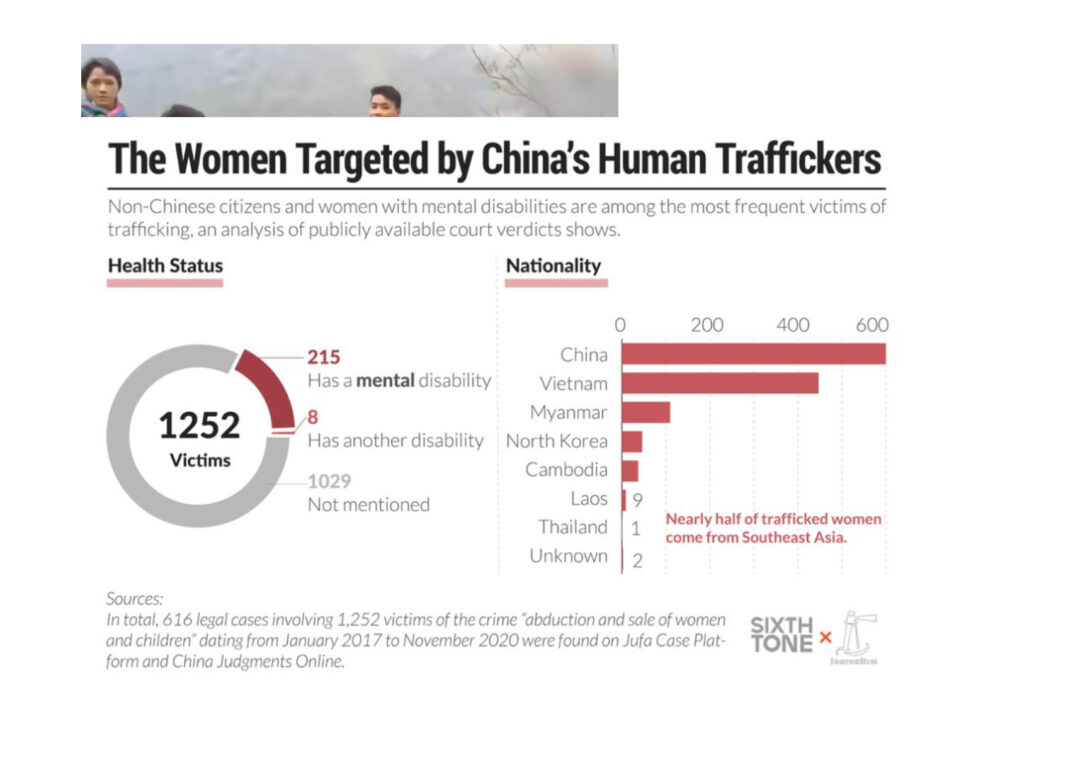Recent media reports have revealed that the trafficking of Vietnamese girls andwomen into China for forced marriages is once again in full swing. The illicit practice had largely stopped since 2020 due to Covid-19 and China’s border restrictions. But,its resurgence came to light again this year with a fatal car accident involving Vietnamese women, likely victims of trafficking, in a Chinese border town as well as the busting of a trafficking ring in Vietnam involving underage Vietnamese girls being sold into China for marriage. It is a grim reminder that the persistent gender imbalance in rural areas of China, where millions of men struggle to find wives, continues to make women’s trafficking a lucrative business.

Workings of the System
The gender imbalance in China is a consequence of the cultural preference for sons, which led to a higher number of female fetuses being aborted during the one-child policy era. Census data from 2020 revealed a significant disparity, with 17.5 million more men than women among Chinese aged 20 to 40. These surplus men, known as “bare branches,” struggle to find spouses and continue their family lineage.
Historically, trafficked brides primarily came from impoverished regions within China. However, in recent years, more brides have been trafficked from countries like Vietnam, Myanmar, and North Korea. The Chinese traffickers employ various tactics, such as offering job opportunities or posing as potential boyfriends, to entice and deceive women into travelling to China. They usually target young women in their 20s or 30s from rural areas of Vietnam. Then the women are either abducted, drugged, or enticed with false promises of good jobs or trips as tourists.
Thereafter, the Chinese traffickers who receive the women upon their arrival in China provide accommodation, contact agents, and transport the women throughout the country. The trade also involves middlemen or matchmakers in Chinese towns and villages who facilitate the trafficking process by sourcing the buyers, who are the ultimate recipients of the trafficked individuals.
As per China’s own official data, 616 cases of trafficking were recorded between 2017 and 2020, involving 1,252 victims. According to latest reports from 2022,
Vietnam recorded 247 suspected traffickers in 90 cases with over 1,100 victims. Most of the victims were uneducated women and children hailing from impoverished areas. On the other hand, along the northern border with North Korea, many women fleeing the Pyongyang regime are sold into prostitution or marriage with Chinese men. These women, along with other North Korean escapees, are often detained by Chinese authorities and over 2000 such women are said to be held in detention centres near the China-North Korea border. Once Covid-related border controls are lifted, China is expected to repatriate these detained North Koreans, putting even North Korean women married to Chinese men at risk of execution or imprisonment. Human rights groups have time and again urged China to protect the rights of North Korean women who are married to Chinese citizens and have children.

A Reluctant Response
The attention on the issue of women being sold as brides in China increased after a video of a woman chained in a shed went viral in 2022. Officials responded with a national campaign to locate and rescue women who had been forcibly sold into marriage. The central government authorised a crackdown on trafficking in women after Premier Li Keqiang prioritised this issue in his annual government work report of 2022, as necessary to ensure political security and social stability. The Chinese officials may have pledged to punish human traffickers severely, but the momentum of the crackdown campaign seems to already have waned. Little official information has been released recently regarding efforts to combat trafficking. In several recent media reports, requests for comments from China’s State Council and immigration authority went unanswered.
Excluded Voices Worsen the Challenge
The Chinese government’s failure to effectively address this problem is a result of deep-rooted corruption and the marginalisation of women from policy-making and enforcement. Although the male-dominated Chinese government can certainly address issues that primarily affect women, the limited representation of women in decision-making positions severely hampers progress. It is evident that true change will require equal opportunities for Chinese women to lead.
In the early 20th century, China’s revolutionary leaders had recognised the importance of women’s rights. Even after the Communist government took power in 1949, it abolished feudal practices and provided women with the right to divorce while encouraging their participation in the workforce. However, as China transitioned to a market-oriented economy, gender discrimination in the workplace became a chronic issue. Women faced layoffs, and the proportion of women with paying jobs decreased over time.
Gender discrimination persists in Chinese hiring practices, exacerbated by the lack of enforceable discrimination laws. Additionally, China’s retirement law sets a lower retirement age for women, limiting their career advancement. Female representation in the Communist Party is also low, hindering opportunities for women to hold leadership positions.
Such root-and-branch exclusion of female perspectives from decision-making contributes to the persistence of problems like trafficking. The trafficking trade emerged as a response to declining female populations in rural areas, driven by factors such as sex-selective abortions and out-migration. Today trafficking has become a lucrative business, with thousands of cases reported annually. However, authorities have not treated these crimes against women seriously, and the penalties for trafficking offences remain relatively low. To effectively combat trafficking, the Chinese authorities need to recognise it as a crime against women and children, rather than solely focusing on political stability. The leadership of women is crucial in driving meaningful change in addressing these issues.


